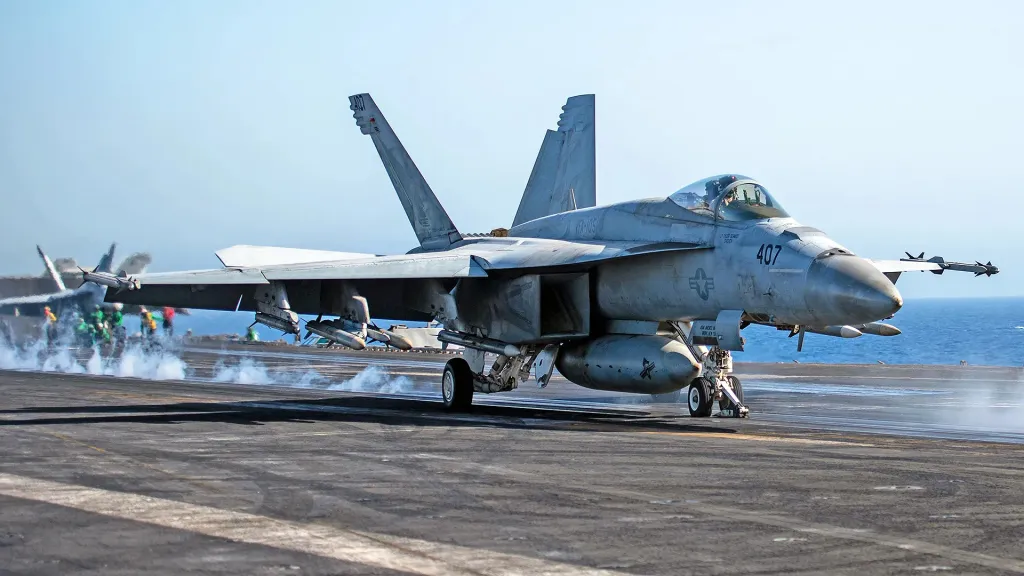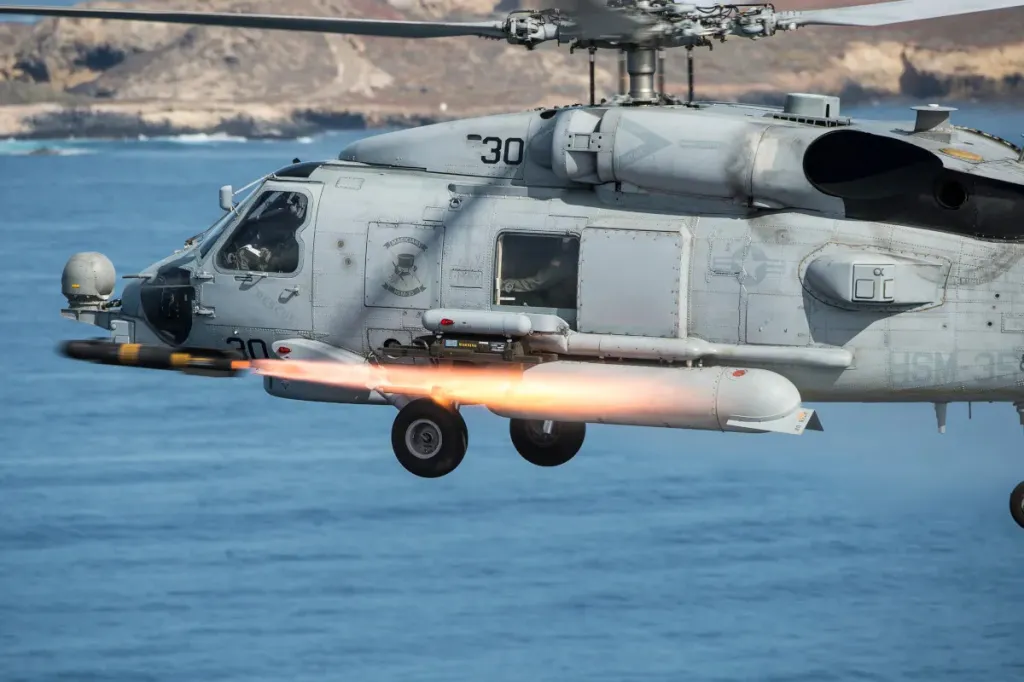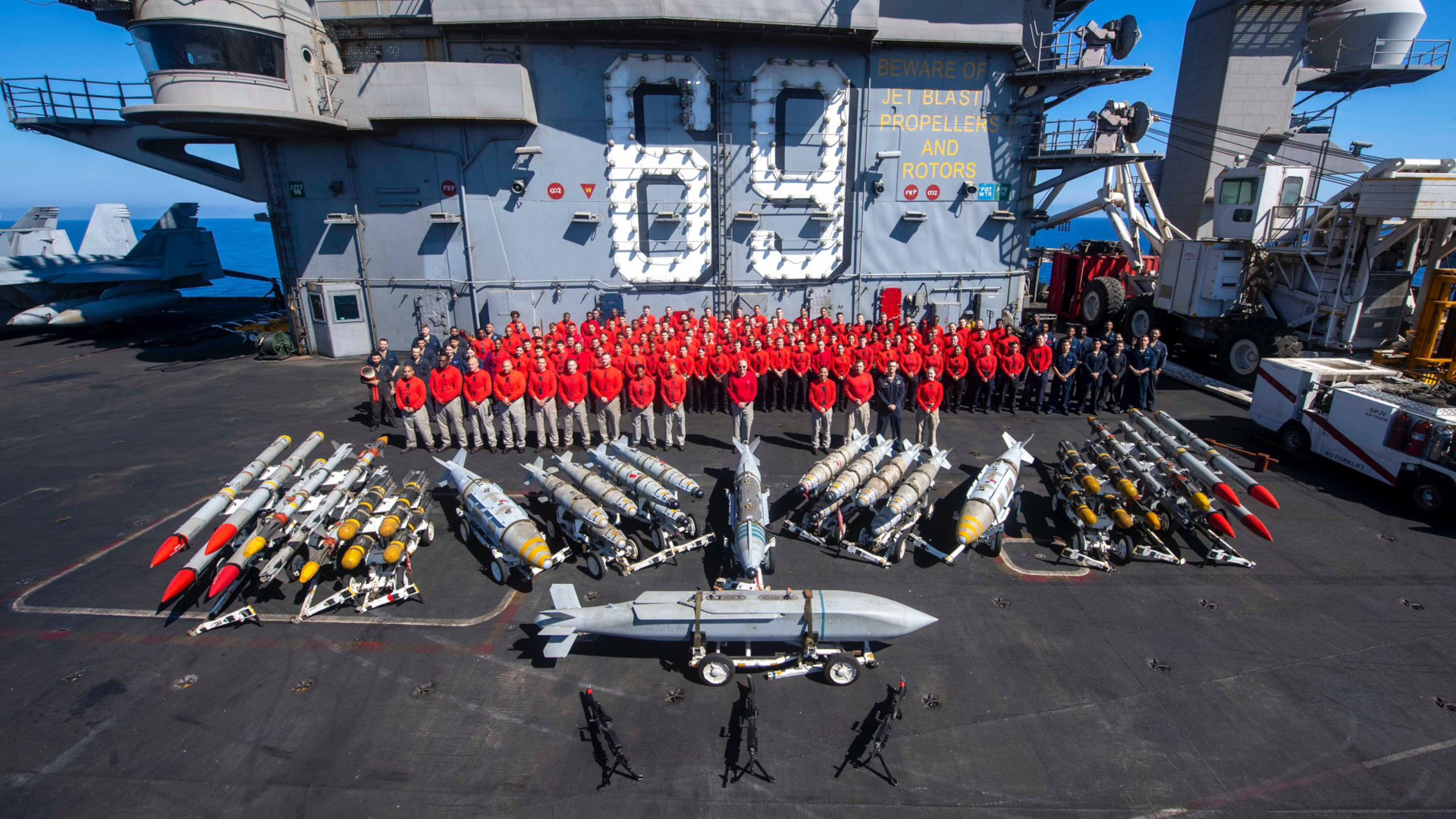Ships assigned to the USS Dwight D. Eisenhower‘s carrier strike group (IKECSG) fired 155 Standard-series missiles and 135 Tomahawk cruise missiles in operations against Iranian-backed Houthi militants based in Yemen during a recently concluded nine-month deployment. Aircraft from the strike group launched another 60 air-to-air missiles and 420 air-to-surface munitions in the course of their operations in and around the Red Sea. Collectively, the IKECSG used its various weapons to destroy a bevy of Houthi aerial drones, missiles, uncrewed surface vessels and undersea vehicles, and different kinds of targets ashore.

The Nimitz class USS Dwight D. Eisenhower, as well as its air wing, and its escorts – the Ticonderoga class guided-missile cruiser USS Philippine Sea (CG 58) and the Arleigh Burke class guided-missile destroyers USS Gravely (DDG 107) and USS Mason (DDG 87) – had first deployed in October of last year. The carrier, commonly known as just “Ike,” returned to its homeport yesterday. Between November 2023 and June 2024, the IKECSG was actively involved in combat operations against Iranian-backed Houthi militants in Yemen and to defend against threats the group launched at warships and commercial vessels.
Two additional Arleigh Burke class destroyers, the USS Laboon (DDG 58) and USS Carney (DDG 64) also augmented the IKECSG during periods of its deployment. Carney destroyed 65 Houthi drones and missiles by itself during its deployment, which wrapped up in May. It’s unclear how, if at all, the missiles those ships launched factor into the munition expenditure figures the Navy has now provided for the IKECSG over the past nine months.

“IKECSG units engaged dozens of one-way attack uncrewed aerial vehicles, uncrewed surface vehicles (USVs), and uncrewed underwater vehicles, earning awards including the Combat Action Ribbon and Navy Unit Commendation award. Several aviators were also awarded personal medals for their exemplary actions,” the Navy’s release says. “Houthi targets in Yemen [that were struck] posed an immediate threat to U.S., coalition, and merchant shipping, and these strikes were designed to degrade Houthi offensive capabilities across more than 460 pre-planned, dynamic, and self-defense targets.”
No specific breakdown of the 155 Standard Missiles (SM) the IKECSG employed during the deployment is provided in the Navy’s release, but the service has previously said that SM-2s and SM-6s have been fired in the course of operations against the Houthis. USS Carney (as well as USS Arleigh Burke) also launched SM-3s as part of the U.S. military’s contribution to the defense of Israel from Iranian drones and missiles in April, which was the combat debut for that missile. However, the destroyer does not appear to have been formally attached to the USS Dwight D. Eisenhower at that time. Eisenhower and its air wing were reportedly not involved in the response to Iran’s attacks.
The Navy’s press release also does not provide any details about any other weapons the ships of the IKECSG may have employed. USS Gravely, for instance, reportedly used its Phalanx Close-in Weapon System (CIWS) at least once to down a Houthi missile.
We also don’t have specifics about what types of air-to-air and air-to-surface munitions aircraft assigned to the IKESCG launched during the deployment. However, earlier this month, Eisenhower‘s commanding officer, Capt. Chris “Chowdah” Hill posted a picture on social media, seen below, with the caption “Mighty Ike weapons department. Guess what they did in the Red Sea.” That picture shows AIM-120 Advanced Medium Range Air-to-Air Missiles (AMRAAM), AIM-9X Sidewinder air-to-air missiles, AGM-114 Hellfire air-to-surface missiles, multiple types of 500-pound and 2,000-pound class Joint Direct Attack Munition (JDAM) precision-guided bombs, and an AGM-154 Joint Stand-Off Weapon (JSOW) glide bomb.
Eisenhower‘s F/A-18E/F Super Hornets would have been the aircraft responsible for employing the JDAMs and JSOWs, as well as AIM-9Xs, and would have been the primary launch platforms for AIM-120s. Ike’s Super Hornets were the first to be spotted taking advantage of new capacity to carry more AIM-9Xs per sortie, the result of a crash Navy effort in direct response to operational demands in and around the Red Sea, a development The War Zone was first to report.

MH-60R/S Seahawk helicopters flying from the carrier and other ships in the strike group would been the ones firing AGM-114s.

Conspicuously absent in “Chowdah” Hill’s munitions picture is the AGM-88E Advanced Anti-Radiation Guided Missile (AARGM), which EA-18G Growlers flying from Eisenhower also fired during the recent deployment. One of the Growlers notably blew up an Mi-24/35 Hind gunship helicopter on the ground with one of these missiles, earning it an unusual kill marking, as The War Zone was first to confirm. The Navy also rushed to expand the EA-18G’s capacity to carry AIM-120 missiles in light of the situation in the Red Sea, but whether or not any of Ike’s Growlers scored any air-to-air kills is unknown.

During the deployment, various aircraft in Eisenhower‘s air wing began sporting their own “victory marks” reflecting air-to-air kills and successful air-to-surface strikes as a result of actions in and around the Red Sea.
Many of these weapons were used in direct defensive actions to protect commercial shipping and U.S. Navy and allied warships operating in and around the Red Sea and Gulf of Aden. While there is no price on human life and even a drone packed with explosives could severely damage an American destroyer, putting it out of action for months and possibly injuring or killing members of its crew, it’s interesting to put a price tag on what these weapons might have cost. This is becoming an increasingly important issue as the U.S. evaluates its own stockpiles and what would be needed to sustain a conflict in the Pacific against a foe exponentially more powerful than the Houthis.
Without knowing the exact breakdown of the missiles and other munitions employed during the IKECSG’s recent deployment, it is impossible to put a dollar figure on all of the weapons expended. The unit price of a single Block V Tomahawk is $1.89 million or so, so launching 135 of those missiles would have cost the Navy $255,150,000.
The War Zone also put together other cost data on Navy ship-launched missiles for a video on our YouTube channel earlier this year. The price of a single SM-2 Block IIIC, the most advanced version of that missile currently in service, is around $2.53 million. The unit cost for the latest version of the SM-6, the Block IA, is some $4.27 million.

When it comes to the air-to-air missiles, the unit price of an AIM-120D AMRAAM is $1.03 million, according to the Fiscal Year budget request for the U.S. Air Force, which is the lead service on that missile. The proposed budget for that fiscal year for the Navy, which manages the AIM-9X program, puts the cost of a single one of those missiles at almost $451,968.
Back in April, Secretary of the Navy Carlos Del Toro disclosed at a Congressional hearing in April that his service alone had already expended at least $1 billion worth of munitions in operations against the Houthis since October 2023 and in the defense of Israel that month. The Navy was reported to have hit the 100 Standard Missiles fired mark by February of this year.

If nothing else, the IKECSG’s significant missile and other munition expenditures underscore the scale and scope of the wide-area defense operations covering commercial ships in and around the Red Sea, as well as strike Houthi targets on the ground in Yemen.
“At sea, Philippine Sea and Gravely successfully escorted over 28 high-value, vulnerable units conducting innocent passage through the Strait of Hormuz, Gulfs of Oman and Aden, Bab al-Mandeb Strait, and through the Red Sea,” the Navy’s press release notes. “Laboon rescued stranded civilians in the Red Sea and returned them to the regional coast guard. Philippine Sea and its embarked detachment of MH-60R helicopters from Helicopter Maritime Strike Squadron (HSM) 74 rescued 24 civilian mariners in distress after a USV struck the M/V Tutor in the southern Red Sea.”
The Liberian-flagged, Greek-owned Tutor was attacked in June and became the second ship the Houthis have actually sunk in the course of their anti-ship campaign. The Belize-flagged, UK-owned M/V Rubymar sank in March following an attack the previous month. Despite the actions of U.S. and European Union-led naval coalitions, the Houthis have succeeded in damaging many more commercial vessels, some very severely.
“When called upon, the force brought the fight to the Houthis in their front yard, linking airpower and dynamic and self-defense strikes. These acts reduced the risk to shipping and also reinforced our nation’s commitment to maritime security,” Vice Adm. George Wikoff, commander of U.S. 5th Fleet in the Middle East, said in a statement following the IKECSG’s return home. “The currency used to fund this important mission was incredible focus, resiliency and professionalism of the sailors of the IKE Carrier Strike Group over eight months [on station]…this is the Navy’s finest moments since World War II.”
The U.S. military has already made clear it is working to draw lessons learned from what it has experienced in the course of operations against the Houthis since last October. The crisis has already shone a light on a host of operational and logistics, especially the Navy’s current lack of any way to rearm ships at sea, that present concerns well beyond the current crisis in the Red Sea. These are topics The War Zone explored in detail in the context of the Navy’s troubled Constellation class frigates in a feature earlier this year that you can find here.
The IKECSG’s now-finished historic nine-month deployment by itself looks set to provide especially valuable insights for the Navy to work with going forward. Operations against the Houthis are also still continuing apace with the carrier USS Theodore Roosevelt and its strike group now having taken over in the Middle East.
Contact the author: joe@twz.com
